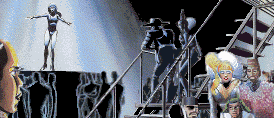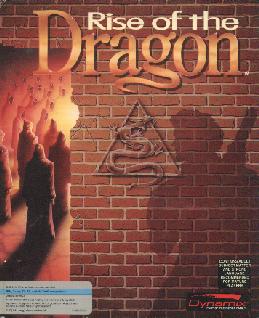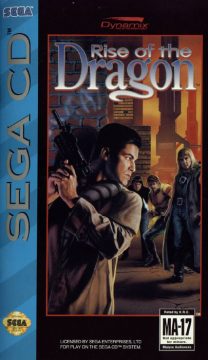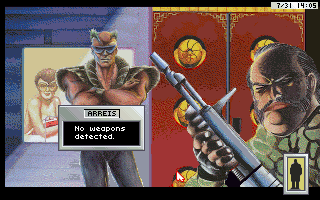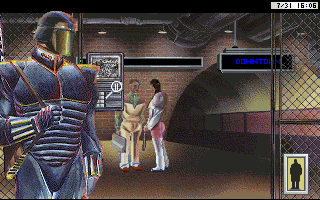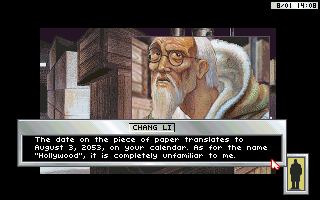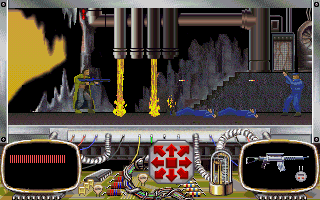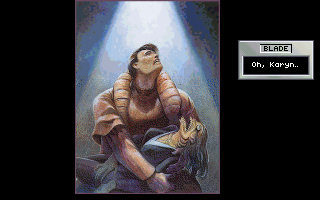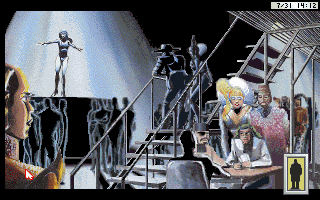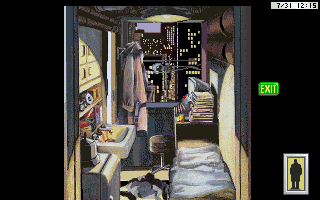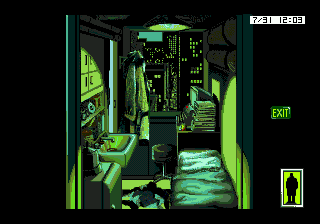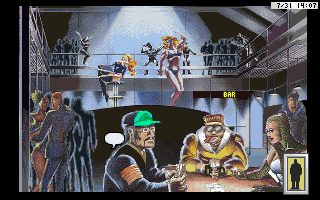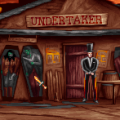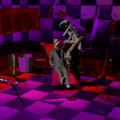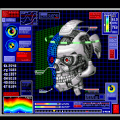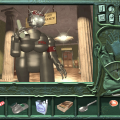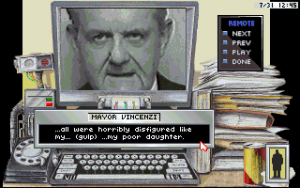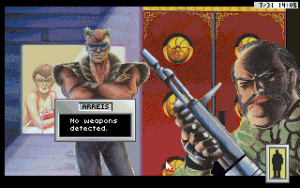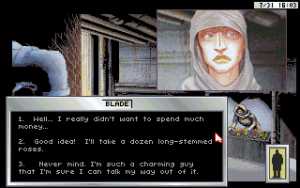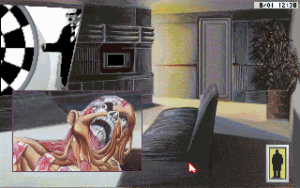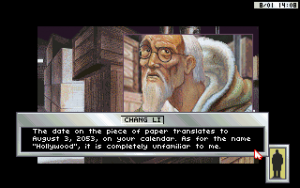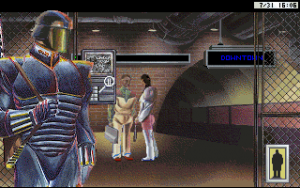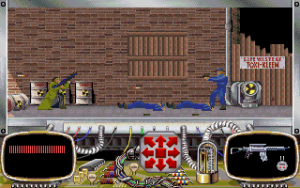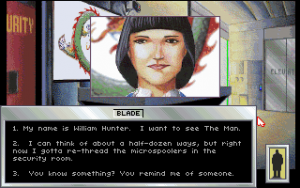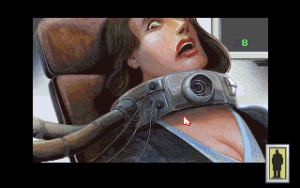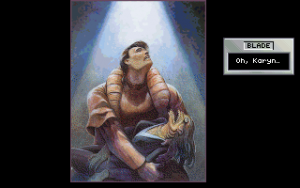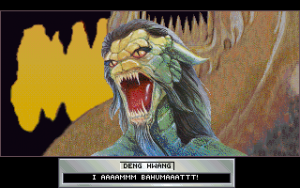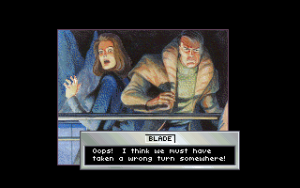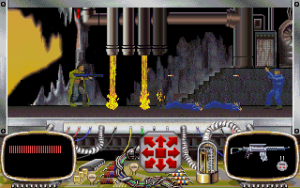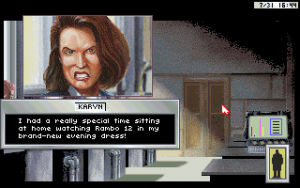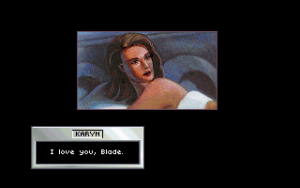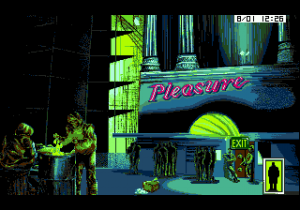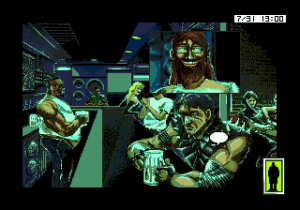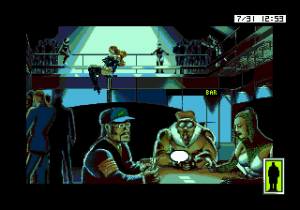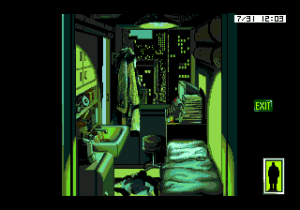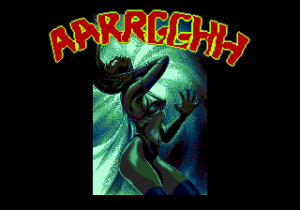Rise of the Dragon is one of the three adventure games, along with The Adventures of Willy Beamish and Heart of China developed by Dynamix during their ownership by Sierra. This dark cyberpunk detective story takes place in futuristic Los Angeles, as you take on the role of detective William “Blade” Hunter to save the city from an underground Chinese drug ring/cult.
The intro, told in comic book style panels, focuses on a young woman taking a hit of a new street drug in a night club. Rather than delivering her a good time as expected, they end up twisting and mangling her body into some kind of inhuman creature, leaving the abomination dead on the floor. As it happens, this young woman is actually the daughter of the mayor. Seeking some good old-fashioned under-the-table justice, the mayor hires Blade to uncover the secret behind his daughters’ death. In the process, he ends up stumbling onto a plot to not only poison Los Angeles’ water supply with these gene-altering drugs, but also to unleash a 5,000 year old dragon named Bahumat into the world. Meanwhile, Blade struggles with his prophesized role as the “chosen one” – administered by a seemingly crazy old Chinese man in an abandoned warehouse – who will save the city, and world, from chaos. It’s a combination of Blade Runner‘s aesthetics with some of Big Trouble in Little China‘s sillier elements of Chinese mythology, though largely without any of its intentionally cheesy B-movie undertones.
Rise of the Dragon is played entirely with a first person perspective, using some gritty hand drawn artwork for its backgrounds and portraits, along with a handful of few black and white digitized images. Stylistically, it looks pretty good, although the scanned drawings suffer some dithering due to the 256 color limit. Navigation is quick and easy, although it takes awhile to adjust to the game’s attention to realism. For example, it’s entirely possible to forget your card key in your computer and leave, effectively locking you out of your apartment. (There is a way to get back in, although it’s a bit obscure – you need to hit the steam valve in the apartment hallway, but there’s no hotspot to indicate that you can interact with it.) Taken even further, you can also forget to put on your clothes and end up getting arrested for public indecency. The first few “puzzles” of the game seem to revolve around not forgetting to pick up certain items, in ways that aren’t always logical. (Who leaves a key in a lock after opening a door, honestly?) A lot of this is done to make the game more realistic, which the game otherwise does more admirably. Certain locations change and have different inhabitants or even music every time you revisit them, which goes a long way towards making the Los Angeles of the future more alive.
Beyond some of the initial “gotcha” moments, Rise of the Dragon isn’t terribly hard nor terribly long. Most of the puzzles are logical and straightforward, and a number of them simply involve navigating through dialogue trees without pissing off whomever you’re talking too. Unfortunately, the “right” answer isn’t always apparent – sometimes you need to play the wiseass, sometimes you don’t – and getting it wrong means that they’ll stop talking to you completely, again, forcing a reload. You also need to be careful about not pissing off your girlfriend, Karyn, who also happens to work in the city’s Bureau of Records. If you manage to find yourself in the doghouse, via saying something stupid, or forgetting a date with her, or picking up a prostitute, you are, once again, stuck in an unwinnable situation.
Per usual adventure game protocol of the late 80s/early 90s, there are a handful of action sequences. One is a fairly painless shooting gallery, wherein you use your mouse cursor you shoot enemies, but two others are side-scrolling console style segments. Both are abysmal, with stiff and lumbering controls, aggravating insta-kill obstacles, and enemy shots that are impossible to dodge. At least the computer versions let you skip these after failing them five times. Beyond these, there’s a truly aggravating puzzle involves wire tapping into an electric box, which is only really irritating because the clues you’re given are quite vague, and you’re under a strict time limit.
For as aggravating as some of these aspects are, Dynamix games have also been fairly freeform in their design. Although the basic plot is linear, you can take on the early tasks in any order, and there are a couple of alternate branches that can potentially make things easier. At one point you can try to bribe the mayor – nothing you need to do, but you’re rewarded with a better weapon, which is handy for making those action scenes suck a little less. You can try to save your informant, trigger an action scene and eventually allowing you a different way to enter Bahumat’s HQ.
The whole game runs in real time, as Blade wakes up every “morning” at noon and shuffles to bed at 1 AM. Switching between locations also takes a set amount of time, so it’s possible to run down the clock if keep randomly running around. There is a time limit to adhere to – you’re given a couple days to take down Bahumat’s factory, and then another day or so to actually stop him – but despite the pressure, it’s actually quite easy to accomplish everything you need to well under schedule, unless you specialize in screwing around. It’s also quite short – if you vaguely know what you’re doing, you can plow through the whole game in well under two hours.
The plot really isn’t anything special nor the design particularly inspired, and other than things like hovering cars and videophones, it never really takes advantage of its cyberpunk setting – it may as well be standard detective story that just happens to be set in the future. There are occasional bits of humor peppered throughout – other than a few goofy lines of dialogue, and the aforementioned ability to get arrested for indecent exposure – you can fling Blade off the edge of his apartment building (apparently still under construction) – but beyond these, most the death sequences are fairly serious.
While Blade’s relationship with Karyn isn’t really much of an issue beyond the opening steps of the game, she ends up captured by Bahumat’s group, and found strapped to an operating chair, as a timer counts down to inject drugs into her system. If you screw up, she’ll morph into horrific, bulge-eyed reptillian monstrosity before your very eyes and die in Blade’s arms as he swears revenge. It’s pretty rough to watch, although saving her isn’t too difficult. The ending changes depending on whether or not you save her, although keeping with the detective noir sensibilities, even the good ending isn’t particularly upbeat.
Rise of the Dragon was met with numerous accolades when it was released, but it’s definitely a product of its time. Arguably, it’s aged worse than either of the other two Dynamix adventure games – it lacks the slapdash cheesiness of Heart of China, and the subversive cartoon attitude of Willy Beamish, leaving only its slightly bleak atmosphere and plot branching to have it stand out. Several other similar cyberpunk games, including Konami’s Snatcher (released a few months after for the Sega CD), Creative Reality’s Dreamweb, and Westwood’s Blade Runner (which admittedly came eight years later) all pull off various elements from Rise of the Dragon, and do it better. It’s not bad though – think of it as a disposable if enjoyable pulp detective novel and it’s a quick, enjoyable playthrough.
In addition to the initial releases for the PC, Macintosh, and Amiga on floppy disk – which are all largely similar other than slight differences in color palette and sound quality – Rise of the Dragon was one of the few Sierra/Dynamix games ported to the Sega CD. The subtitle “A Blade Hunter Mystery” is added to the title screen, implying that it would be part of a larger series, although that never happened. It’s actually a pretty quality production, with fully voiced dialogue and substantially enhanced sound. While there are some cheesy lines, especially with the Chinese accents, the voice acting adds quite a bit to the atmosphere, and enhances the otherwise average writing. It stars several well known voiceover artists, including the ubiquitous Cam Clarke as Blade. However, the character portraits still aren’t animated, with completely static pictures as they speak, and all of the subtitle text is gone.
The music has also been improved, taking advantage of the Sega CD’s PCM channel to add some classy percussion to the songs from the computer versions, which further enhances the atmosphere. The visuals do suffer due to the limited color palette – instead of further dithering them, however, the whole game has a severe green tint. It looks strange if you’re familiar with the PC version, but you can adjust to it quickly, especially if you’re playing on a standard TV.
Some animated background elements are cut out, and the date was Karyn is cut short, since it implied some sex. Even though absolutely nothing was shown, and all of the disturbingly violent deaths are intact (complete with hysteric shrieking), coupled with the MA-17 rating, apparently this type of scene was just too much for a console. Strange, especially considering it was hardly superfluous, and showed more of Karyn and Blade’s relationship. Despite the censorship, at least unlike other adventure game ports, the load times are relatively speedy, so it’s not nearly as painful as Willy Beamish or Monkey Island. The other major snag is that the action sequences are now unskippable, probably because the developers figured console gamers would be able to handle them. If it weren’t for this and the graphics, this would be the definitive version of Rise of the Dragon.
Screenshot Comparisons
